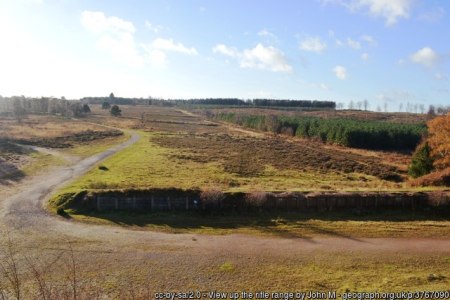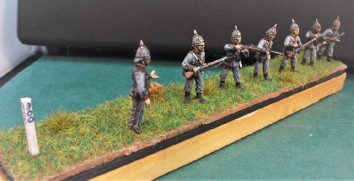Presenting the finished group of Cheshire Rifle Volunteers! My little cohort consists of men of the 1st Cheshire Rifle Volunteer Corps under instruction from an officer. Out on the rifle range, they are firing their Martini-Henry rifles at targets some 300 yards away. The year is 1884 and a county-wide shooting competition is but a week away. Some further rifle practice is needed if the Cheshire Grey’s best shots are to be in with a chance of winning that silver cup…
A little research revealed to me that the remains of long-forgotten Victorian volunteer rifle ranges do still exist around the UK, some being more readily visible than others. It seems that many of these rifle ranges fell out of use sometime before the Rifle Volunteers final absorption into the new Territorial Force in 1908. Perhaps a dwindling interest in the movement was to blame, but after 1908 I suspect that the Territorial Force’s closer ties to the county regiments of the regular army meant the volunteer battalions might have made use of the regular’s facilities instead.

Finding appropriate drill space and rifle ranges in the early years of the movement occasionally proved problematic and caused friction with the local population. However, during the heydey of the Rifle Volunteers, the activities of the local corps could become important social events. In 1861, for example, a county-wide rifle competition was watched by a crowd estimated to be up to 30,000!

The Rifle Volunteer movement always emphasised high standards of marksmanship. So, target practice at the rifle range – described at the time as ‘that interesting, healthful and manly exercise which the Rifle movement is supposed to supply’ – was seen as the main way of maintaining the enthusiasm and skill of the volunteers. An 1864 account of a Buckinghamshire Volunteers rifle competition suggests that the chief source of motivation wasn’t always the silverware however:
“The Volunteers were cheered in no small way by the presence of a good sprinkling of the Ladies, who with a bravery not common to the sex, boldly faced the wind and appeared to take great interest in the proceedings…”


A 2015 story in a provincial newspaper reported on the discovery of an old rifle range which had been apparently completely forgotten by the local community. Using a metal detector, a former soldier turned amateur archaeologist was first alerted to its existence when he discovered many Victorian-era bullets in the area, saying “...the oldest is the .577/450 Martini-Henry, which came into service in 1871 and is famous for being used during the Anglo-Zulu war of 1879.”

He located an 1880 edition of a map of the area and discovered the rifle range was clearly marked upon it. The locator of the range, Mr Beddard, goes on to describe how the range is depicted on this old map:
“It was marked ‘volunteers’, with the firing positions running from the Dudley direction for 850 yards, spaced out every 50 yards up to the target area. Some have marked firing trenches, some have raised firing positions.”
For my own models, I’ve simply included a distance marking post with my group, demonstrating that they are firing at a range of 300 yards from the targets. Not sure what form these posts would have taken, so I’ve simply used my imagination here!
A 2012 archaeological survey report by Herefordshire Council of a Rifle Volunteers’ firing range on Bromyard Downs provides a further insight into the nature of a Victorian Rifle Volunteer’s rifle range:
“The Bromyard range was, like most Volunteer ranges, extremely simple, though some were even more basic in the facilities they offered. Simplest of all was the range on Coppet Hill, Goodrich, with a single lane ending at a target in a small excavation marked as an old quarry, with no intermediate firing points indicated and no flagstaffs. At Aston Ingham near Newent, too, a single target was accommodated in a small delve cut into the rising ground”

Others, it seems, could be more elaborate. Some would feature shelters for the riflemen acting as markers and observers. These took the form of emplacements behind the butts or as brick huts placed to the side of the range. Shooting platforms or trenches were sometimes provided, although I imagine that for many ranges firing positions would consist simply of open grassland with distance marker posts – as in my little diorama. In the Bromyard Downs report, it goes on to describe the target end of the range:
At the butts end, the map shows the targets (plural) as a solid square structure projecting forward from a short straight line. Immediately behind the targets was a backstop shown as an earthwork mound 11 yards long with its west end curving forwards. As well as a backstop, this may have acted as a mantlet, protecting the Volunteers on marking duty. Behind that… was a second embankment on the hillside above, no doubt to stop high rounds from ricocheting off the rising ground; the map bears the legend ‘Butts’ between the two embankments. There was also a flagstaff a few yards to the east, which would have given formal warning that firing was taking place and would have aided the shooters by indicating wind strength and direction at the target.

Stop giggling at the back! There is nothing amusing about being ‘at the butt’s end’. In the example of the Bromyard range, it seems possible that the targets consisted of a marked iron plate, a notion supported by a number of severely flattened spent bullets.
Next, I might put a label on the wooden plinth indicating what the figures represent…
Well, as the painting of these Perry Miniatures figures have been far from anything like a pain in the ‘butt’, be warned that I’ll be continuing this little Volunteer Rifle Corps project with my next small batch of riflemen representing another corps, some of which have already been glued together. More details to follow!












Beautifully painted figures and a fascinating bit of digging around and research … as interesting as the bizarre Palmerston Forts or Follies, which I think we’re in the first flush of Rifle Volunteering 1860s? Tempting to run a Victorian Britain Operation Sealion (“Operation Lion de Mer”?) against the invading Napoleon III French …
LikeLiked by 1 person
That Operation Lion de Mer sounds like a great idea! Wargaming the Battle of Dorking! I’ve been to a couple of Palmerston Follies in recent years – Nothe Fort and Hurst Castle on the south coast. You’re right, they were commissioned about the same time as the Rifle Volunteer movement. Trouble was – within a decade or so even the enormous Armstrong guns were being made obsolete being massively out-gunned by modern warships and the Dreadnoughts!
LikeLike